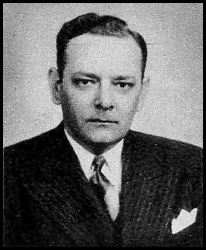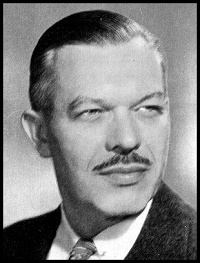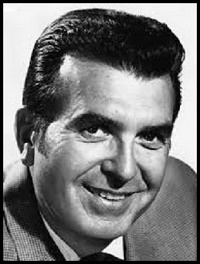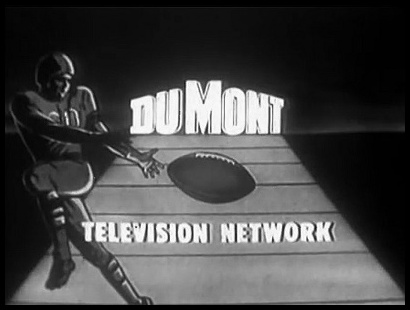(Editor's Note: The following paragraphs are reprinted in a slightly abridged form from The Complete Directory to Prime-Time Network and Cable TV Shows, 1946-Present, 6th Edition. Copyright © 1995 Tim Brooks and Earle Marsh, all rights reserved.)
News
DuMont never had the financial resources of the other
television networks and, though it was second only to NBC with a
regularly scheduled evening news program, the DuMont news never evolved
into the complex and comprehensive effort that its competitors were to
become by the early 1950's.

Above: Walter Compton
The first DuMont network news show, carried on a
two-station network, was 1947's Walter Compton News. The first network
news series to originate from Washington, D.C., where it had been seen
since June 1947, Walter Compton News became a network program when it
was seen simultaneously in New York starting in August. The production
was minimal, with Compton reading from a script and only occasional
slides being shown.

In January 1948 Camera Headlines, a filmed 15-minute
newsreel, was added to the DuMont schedule at 7:30pm. Since Camera
Headlines dealt only with domestic stories, INS Telenews followed it on
Tuesday nights to provide world news coverage. The INS Telenews newsreel
was a wrap-up of the major world news stories of the week, provided to
DuMont by Hearst's International News Service, essentially a print
service similar to UPI and AP.
Not precisely a hard-news show, Newsweek Analysis
premiered in November 1948. Moderated by senior Newsweek editor Ernest
K. Lindley, it was an interview program in which various editors of the
magazine chatted with personalities in the news. When the series moved
from Sundays to Mondays the following February, the title was changed to
Newsweek Views the News.

Above: Morgan Beatty
In the fall of 1954, after an absence of almost five
years, regularly scheduled nightly news returned to the DuMont network.
Anchored by Morgan Beatty, this show (the DuMont Evening News - ed.)
remained on the air until the crumbling DuMont network virtually ceased
functioning the following April.
Sports
Professional wrestling was a regular and popular form of
entertainment on early, live network television, particularly on ABC
and DuMont. The two longest-running wrestling shows originated from
Chicago -- Jack Brickhouse doing the play-by-play from Marigold Garden
every Saturday night on DuMont for almost six years, and Wayne Griffin
announcing from Rainbow Arena for ABC for roughly the same length of
time. DuMont's other long-running wrestling show originated from various
arenas around the New York City area (Jerome Arena, Jamaica Arena,
Sunnyside Gardens, and Columbia Park Arena) with Dennis James at the
mike.

Above: Dennis James
The most famous of these early wrestling announcers was
probably DuMont's Dennis James, whose simplified explanations and
infectious enthusiasm made the sport palatable even to little old
ladies. His oft-repeated phrase "Okay, Mother" became so identified with
him that it was later used for the title of one of his numerous daytime
game shows. That a game-show emcee like James could become wrestling's
most famous commentator was perhaps symbolic of the fact that on TV,
wrestling was more show business than sport.

DuMont's programming was heavy with both boxing and
wrestling in the late 1940's and early 1950's. With its limited
finances, inexpensive programming that had a ready audience was
something that DuMont could not resist. Dennis James was DuMont's sports
announcer for boxing and wrestling. The DuMont boxing shows, however,
could not afford traveling to locations where there were no DuMont
stations, so that most of them originated from the New York area. Dennis
James covered bouts from Jamaica Arena, Queens, on Mondays, from Park
Arena on Tuesdays, from White Plains, New York, on Wednesdays, and from
Sunnyside Gardens and Dexter Arena on Thursdays.
The longest-running DuMont boxing show, however, did not
have James at the helm. Ted Husing was the announcer when Boxing from
Eastern Parkway (Brooklyn) went on the air in May of 1952. He left in
March of 1953 and was replaced by young Chris Schenkel. When ABC picked
up the show in May of 1954, DuMont and Schenkel moved shop to St.
Nicholas Arena, where they stayed until DuMont went out of the network
business in 1956. Boxing from St. Nicholas Arena was the last DuMont
network series, its last network telecast coming on August 6, 1956,
though it remained on as a local program in New York.

